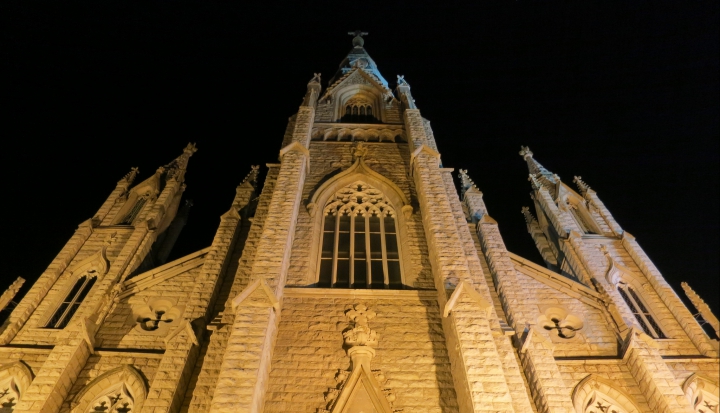Two parishes stand at the heart of St. Louis, Missouri: St. Francis Xavier (more commonly known as College Church, with a congregation that is predominantly European American) and St. Alphonsus (often called Rock Church, with a congregation that is predominantly African American). For most of their history, these churches—each one’s steeple visible from the other—have had very little contact with each other.
However, the death of Michael Brown in 2014 and the advent of the Black Lives Matter movement changed this. Faced with a historic moment that is arguably both an upsurge in racism and a new civil rights movement, the two parishes have decided to cross the symbolic “Delmar Divide” that separates the almost exclusively African American north St. Louis from the white-dominated south and Central West End in order to pursue joint projects.
“We have sat down the street from each other for a hundred years and not collaborated or gotten to know each other,” says Christine Dragonette, who is director of social ministry at College Church. “As a mostly white parish, we have a responsibility to look at how racism shows up in our church—how white people have contributed to it and continue to perpetuate it. We are seeking to build relationships while recognizing that we also have our own internal work to do.”
This initial collaboration led to discussions about the differences between white and black Catholic experience—differences that turned out to be quite marked. A growing awareness of these experiences inspired a group of women from both parishes to write and produce a play, Growing Up Catholic: What’s Race Got To Do With It? which was shown at St. Louis University last October.
The initial idea for the play came from Almetta “Cookie” Jordan, a Rock Church member and arts administrator. Under her leadership, members of both parishes created a questionnaire surveying participants’ experiences growing up Catholic. Jordan and two other writers—Thomasina Clarke and LaVelle Wilkins-Chinn—developed the participants’ responses into a play.
“We deliberately decided to make it an all-female show, as we get a male perspective most of the time, especially in the Catholic Church,” Jordan explains. “We also wanted to make it multigenerational—for example, we included a question about John F. Kennedy even though we knew most of our participants hadn’t been born during his time. We also asked participants to name at least one black saint, to which one respondent wrote, ‘There are actually black saints?’”
That question set the scene that opens the play, which features a small group of young women in an all-girls’ Catholic school discussing the matter with the white nun teaching them religion (and who herself does not know much about black saints until one student decides to do some research and educate her teacher). These school scenes—set in 2015—alternate with ones from a middle-aged women’s card party, where participants reflect on past experiences and current events.
One of the most disturbing and revelatory moments in the play is set in the early 1970s and features three high school students meeting with their high school guidance counselor, who is a nun. The first—a white student—has mediocre grades and little ambition, but the counselor urges her to apply to college. The second—who is African American—is offered a full scholarship to Wellesley College and is urged to turn it down “in her own best interest.” The third—also African American—is met with one simple exclamation: “Surely you’re not going to college!”
“That is my story,” says Thomasina Clarke, who has worked professionally as an actor, writer, director, and drama teacher for over 30 years. “I don’t know if she was trying to start a fire in me or just being negative, but my parents had been expecting me to go to college all along, so I didn’t pay her much heed. In 1971 I was a proud freshman at Xavier University in New Orleans.”
Despite the seriousness of the subject matter, the play is not without lightness and humor. Though done as reader’s theater—with actors sitting on stage and reading from the script—one scene, titled “Sunday Morning Rituals,” is more fully staged. Alternating between a white family and a black one, it features a dialogue between exasperated mothers and their young daughters hurrying to get ready for Mass on a Sunday morning. “In addition to highlighting our differences, we also wanted to show our similarities,” says Clarke. “Everyone has to get ready for church on a Sunday morning. This is a scene I can imagine taking place in many homes.”
Christine Dragonette says that the play taught her a lot about significant African American figures in the church. “I also learned from people middle-aged or older how the racism they experienced growing has not completely changed. Segregation shaped the way churches formed in St. Louis, and that legacy has been maintained,” she says. “But today, especially after the Jason Stockley verdict, in which an ex-police officer was acquitted in the 2011 shooting death of Anthony Lamar Smith, people are starting to realize that the Catholic Church needs to show up now in a way it failed to do so when Michael Brown was killed.”
Both Clarke and Jordan assert that a new civil rights movement is occurring in the United States today and that St. Louis has an important role to play in it. “We seem to be in a cycle that is both good and bad,” says Jordan. “I believe that Black Lives Matter does represent a new civil rights movement, but we’re also seeing a resurgence of the KKK. Also, right now we are so politically divided, with less nuance than 30 or 40 years ago. Today people find it hard to understand why a black person could be a Republican or why a white person would care about African American experience. We’re going back to a kind of separatism I don’t think we’re called to.”
Clarke agrees. “When I was young, my father shocked me by saying he was thankful for Bull Connor, the Birmingham, Alabama politician who enforced segregation. I was initially appalled that my father, an educated man and an attorney, could say this. But he firmly believed that, had it not been for Connor and the news media, people would never have known what was happening to black people in the South,” she says. “Today, black people are tired of being denied their rights. Something like the recent Jason Stockley verdict is just another example of this. So yes, I would say that a new civil rights movement is definitely in process.”
Lisa Burks, a College Church member who acted in the play, says she learned a lot by participating. “Lots of cities claim to be the most segregated in the United States, but unfortunately, St. Louis seems like a good candidate. The separation of neighborhoods and opportunities that is pervasive across the country is very pronounced here. Most white people’s lived experience is that we don’t interact with people of color, which helps to reinforce barriers,” she says.
However, Burks says she remains hopeful and wants to keep the conversation going. “People are realizing that the first civil rights movement did not change everything,” she says. “Today, we are starting to look at the systemic barriers to equality.”
All of the participants argue that the role of the Catholic Church in St. Louis’ racial history is mixed. They all laud Cardinal Joseph Ritter, who desegregated Catholic schools and hospitals in the city during the late 1940s, declaring, “The cross on top of our schools must mean something.” However, they note that, from the early Jesuits who owned slaves to more recent subtle forms of discrimination, the Catholic Church has indeed enforced racism.
“I remember taking a vacation with my family one summer,” says Clarke. “It was a mystery trip—my parents wouldn’t say where we were going, and I am not sure that they knew. Anyway, one Sunday we stopped at a church for Mass. The entire congregation was white. I soon noticed that suddenly, no one wanted to sit near us. I found that so strange—people moved so that no one was in front of, behind, or alongside us. Only later did I realize what the reason was.”
While Clarke laments the ongoing racism that continues to plague the United States, she is not without hope that change is happening. “One of my high school classmates, a white woman, attended the play and came to me in tears afterwards,” she says. “She told me that in all her life, she had never thought of herself as being racist, but now, seeing the show, she recognizes the privilege that her skin color has given her. It meant so much for me to hear that.”
In terms of next steps for the play, the participants hope to gain funding to stage it again—not just as reader’s theater, but as a fully developed production. They also would like to take the message beyond the St. Louis community. “If you say you are a Catholic, be a Catholic,” says Clarke. It may be hard to truly embrace diversity, but I would urge you to put those differences aside. What is the problem that keeps us from appreciating one another? I believe that the difference will be made by people—not black people, white people, Muslim people, or Catholic people. The difference will be made by people.”
Image: Flickr cc via Paul Sableman














Add comment